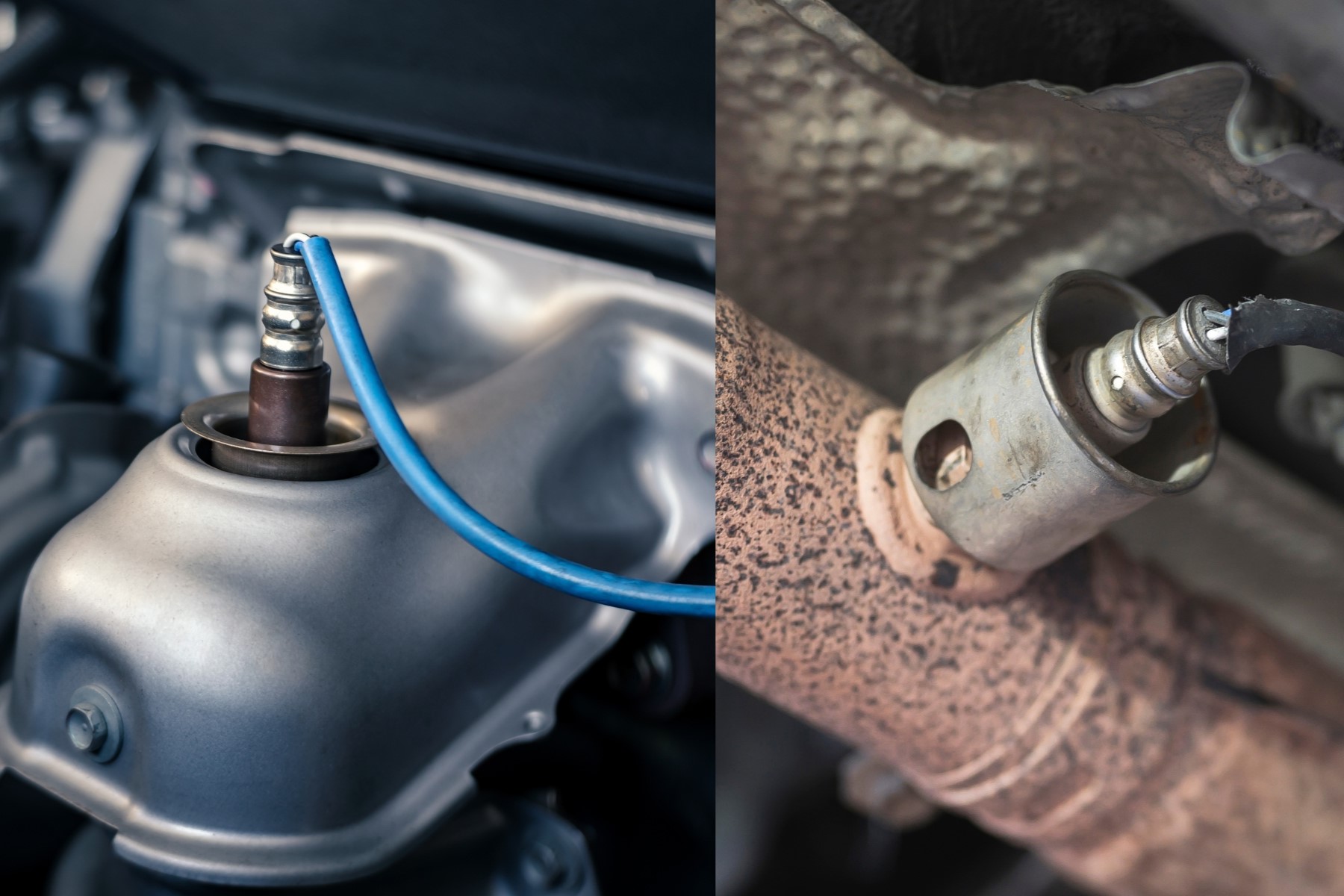Home>Automotive>Unveiling The Mystery: Decoding Upstream Vs. Downstream O2 Sensors!


Automotive
Unveiling The Mystery: Decoding Upstream Vs. Downstream O2 Sensors!
Published: January 20, 2024
Learn the difference between upstream and downstream O2 sensors in the automotive industry. Unveil the mystery behind these crucial components!
(Many of the links in this article redirect to a specific reviewed product. Your purchase of these products through affiliate links helps to generate commission for Noodls.com, at no extra cost. Learn more)
Table of Contents
Introduction
Automotive enthusiasts and DIY mechanics often encounter technical jargon that can seem perplexing at first glance. One such mystery lies in understanding the difference between upstream and downstream oxygen (O2) sensors in vehicles. These sensors play a crucial role in monitoring and optimizing the air-fuel ratio, a fundamental aspect of engine performance and emissions control. Unraveling the distinction between these sensors is vital for anyone seeking to comprehend the intricacies of modern vehicle systems.
The journey to decoding upstream and downstream O2 sensors begins with a fundamental grasp of their functions and locations within the vehicle's exhaust system. By delving into the specifics of these sensors, we can gain a deeper understanding of their significance in ensuring optimal engine performance and environmental sustainability. Let's embark on this enlightening expedition to demystify the realm of O2 sensors and uncover the critical role they play in the automotive world.
Understanding O2 Sensors
Oxygen (O2) sensors, also known as lambda sensors, are vital components in modern vehicles, responsible for monitoring the levels of oxygen in the exhaust gases. This information is crucial for maintaining the ideal air-fuel ratio for efficient combustion within the engine. The O2 sensors are located in the exhaust system, where they continuously measure the oxygen content in the exhaust gases.
These sensors operate based on the principle of a chemical reaction between the oxygen in the exhaust gases and the sensor's internal components. The reaction generates voltage, which the vehicle's engine control unit (ECU) interprets to determine whether the air-fuel mixture is lean (too much oxygen) or rich (too little oxygen). This feedback loop allows the ECU to make real-time adjustments to the fuel injection, ensuring that the engine operates at peak efficiency while minimizing harmful emissions.
There are typically two O2 sensors in a vehicle's exhaust system: the upstream sensor (pre-catalytic converter) and the downstream sensor (post-catalytic converter). Each sensor serves a distinct purpose in monitoring and regulating the air-fuel ratio. Understanding the functionality and significance of these sensors is essential for comprehending their role in optimizing engine performance and minimizing environmental impact.
The upstream O2 sensor is situated before the catalytic converter and provides critical feedback to the ECU regarding the air-fuel mixture entering the exhaust system. This information enables the ECU to make precise adjustments to the fuel injection, ensuring that the engine operates at an optimal air-fuel ratio. On the other hand, the downstream O2 sensor, positioned after the catalytic converter, monitors the efficiency of the catalytic converter and assesses the overall performance of the exhaust after the combustion process.
In essence, O2 sensors play a pivotal role in maintaining the delicate balance between fuel efficiency, engine performance, and environmental sustainability. By continuously monitoring and regulating the air-fuel ratio, these sensors contribute to the overall efficiency and cleanliness of modern vehicle engines.
Understanding the fundamental operation and significance of O2 sensors lays the groundwork for comprehending the specific roles of upstream and downstream sensors in optimizing engine performance and emissions control. This knowledge forms the bedrock for deciphering the differences and importance of these sensors in the context of automotive systems.
Upstream O2 Sensors
Upstream O2 sensors, also known as pre-catalytic converter sensors, are strategically positioned within the vehicle's exhaust system to perform a crucial monitoring function. Situated before the catalytic converter, these sensors are tasked with analyzing the air-fuel mixture as it exits the engine's combustion chambers. By continuously measuring the oxygen content in the exhaust gases, upstream O2 sensors provide real-time feedback to the engine control unit (ECU), enabling it to make precise adjustments to the fuel injection system.
The primary function of upstream O2 sensors is to ensure that the air-fuel ratio entering the exhaust system is maintained at an optimal level for efficient combustion. This feedback loop is essential for achieving peak engine performance and minimizing harmful emissions. The data provided by the upstream O2 sensors allows the ECU to make instantaneous adjustments to the fuel injection, fine-tuning the air-fuel mixture to achieve the ideal ratio.
In practical terms, when the upstream O2 sensors detect a lean air-fuel mixture (excess oxygen), the ECU responds by increasing the duration of fuel injection to enrich the mixture. Conversely, if the sensors indicate a rich air-fuel mixture (insufficient oxygen), the ECU reduces the duration of fuel injection to lean out the mixture. This continuous cycle of feedback and adjustment ensures that the engine operates with optimal fuel efficiency and minimal environmental impact.
Upstream O2 sensors are designed to withstand the harsh conditions of the exhaust environment, including high temperatures and exposure to contaminants. Their robust construction and high-temperature capabilities enable them to reliably perform their monitoring function over extended periods, contributing to the overall efficiency and longevity of the vehicle's emissions control system.
In essence, upstream O2 sensors serve as the frontline guardians of the engine's air-fuel ratio, providing the critical data necessary for the ECU to maintain optimal combustion efficiency. Their strategic location before the catalytic converter underscores their significance in influencing the performance and environmental impact of modern vehicles. Understanding the role and importance of upstream O2 sensors illuminates their vital contribution to the overall functionality and sustainability of automotive systems.
Downstream O2 Sensors
Downstream O2 sensors, also referred to as post-catalytic converter sensors, are integral components positioned after the catalytic converter in the vehicle's exhaust system. While the upstream sensors focus on monitoring the air-fuel mixture exiting the engine, the downstream sensors play a distinct yet equally crucial role in evaluating the efficiency of the catalytic converter and assessing the overall performance of the exhaust gases after the combustion process.
The primary function of downstream O2 sensors is to analyze the exhaust gases after they have passed through the catalytic converter. This evaluation allows the sensors to provide feedback to the engine control unit (ECU) regarding the converter's efficiency in reducing harmful emissions and converting pollutants into less harmful substances. By continuously monitoring the composition of the post-catalytic exhaust gases, the downstream sensors enable the ECU to assess the catalytic converter's performance and make necessary adjustments to maintain optimal emissions control.
In practical terms, downstream O2 sensors serve as watchdogs for the catalytic converter, ensuring that it is operating at peak efficiency in reducing harmful emissions. If the sensors detect an imbalance in the exhaust gases, indicating a potential issue with the catalytic converter's performance, the ECU can initiate corrective measures to address any inefficiencies. This proactive approach to monitoring the converter's effectiveness is essential for maintaining compliance with emissions regulations and minimizing the vehicle's environmental impact.
The strategic placement of downstream O2 sensors after the catalytic converter underscores their significance in evaluating the overall health of the vehicle's emissions control system. By providing critical feedback on the converter's performance, these sensors contribute to the vehicle's compliance with emissions standards and its role in environmental sustainability.
Furthermore, downstream O2 sensors play a vital role in ensuring the proper functioning of the On-Board Diagnostics (OBD) system. The data they provide to the ECU is instrumental in detecting and diagnosing potential issues related to the catalytic converter and emissions control, allowing for timely maintenance and repairs to uphold the vehicle's environmental compliance.
In essence, downstream O2 sensors are essential components that contribute to the overall efficiency and environmental responsibility of modern vehicles. Their role in evaluating the performance of the catalytic converter and facilitating timely emissions control adjustments underscores their significance in maintaining optimal engine performance and minimizing the vehicle's ecological footprint. Understanding the functionality and importance of downstream O2 sensors illuminates their critical contribution to the comprehensive emissions control system integrated into modern automotive technology.
Differences Between Upstream and Downstream O2 Sensors
The primary distinction between upstream and downstream O2 sensors lies in their location within the vehicle's exhaust system and their specific monitoring functions. Understanding these differences is crucial for comprehending the complementary roles these sensors play in optimizing engine performance and emissions control.
-
Location: The most apparent dissimilarity between upstream and downstream O2 sensors is their placement within the exhaust system. The upstream sensor is positioned before the catalytic converter, directly monitoring the air-fuel mixture as it exits the engine's combustion chambers. In contrast, the downstream sensor is located after the catalytic converter, analyzing the exhaust gases after they have passed through the converter.
-
Monitoring Function: The upstream O2 sensor focuses on continuously measuring the oxygen content in the exhaust gases, providing real-time feedback to the engine control unit (ECU) regarding the air-fuel mixture entering the exhaust system. This feedback enables the ECU to make precise adjustments to the fuel injection system, ensuring optimal combustion efficiency. On the other hand, the downstream O2 sensor evaluates the efficiency of the catalytic converter by monitoring the composition of the post-catalytic exhaust gases. Its primary function is to provide feedback to the ECU regarding the converter's performance in reducing harmful emissions.
-
Influence on Engine Control: The data provided by the upstream O2 sensor influences the real-time adjustments made by the ECU to the fuel injection system, maintaining the air-fuel ratio at an optimal level for efficient combustion. In contrast, the downstream O2 sensor's feedback allows the ECU to assess the catalytic converter's performance and initiate corrective measures if any inefficiencies are detected.
-
Role in Emissions Control: While both sensors contribute to emissions control, their specific roles differ significantly. The upstream sensor's monitoring of the air-fuel mixture directly impacts the engine's combustion efficiency and emissions output. In contrast, the downstream sensor's evaluation of the catalytic converter's performance directly influences the vehicle's compliance with emissions standards and its environmental impact.
-
Integration with On-Board Diagnostics (OBD) System: Downstream O2 sensors play a vital role in ensuring the proper functioning of the OBD system by providing critical data to the ECU for detecting and diagnosing potential issues related to the catalytic converter and emissions control.
Understanding the differences between upstream and downstream O2 sensors elucidates their distinct yet complementary roles in optimizing engine performance and emissions control. These sensors work in tandem to maintain the ideal air-fuel ratio, evaluate the efficiency of emissions control components, and uphold the vehicle's environmental compliance, emphasizing their critical contribution to the overall functionality and sustainability of automotive systems.
Importance of O2 Sensors in Vehicle Performance
Oxygen (O2) sensors play a pivotal role in optimizing vehicle performance by ensuring efficient combustion, maximizing fuel economy, and minimizing harmful emissions. These sensors are integral to the engine control system, providing real-time feedback that directly influences the air-fuel ratio and overall combustion efficiency. The significance of O2 sensors in vehicle performance is underscored by their ability to uphold engine functionality, environmental sustainability, and compliance with emissions regulations.
The continuous monitoring of the air-fuel mixture by O2 sensors allows the engine control unit (ECU) to make precise adjustments to the fuel injection system, ensuring that the combustion process operates at an optimal air-fuel ratio. This meticulous regulation of the air-fuel mixture is essential for achieving peak engine performance, maximizing fuel economy, and reducing the vehicle's ecological footprint. By maintaining the ideal air-fuel ratio, O2 sensors contribute to the overall efficiency and responsiveness of the engine, translating into enhanced driving dynamics and fuel efficiency.
Furthermore, O2 sensors play a critical role in emissions control, actively contributing to the reduction of harmful pollutants released into the environment. By continuously monitoring the exhaust gases and providing feedback on the air-fuel ratio, these sensors enable the vehicle to meet stringent emissions standards while minimizing its environmental impact. The data provided by O2 sensors allows for the timely adjustment of the fuel injection system, ensuring that the vehicle operates within regulatory emission limits and upholds its environmental responsibility.
In addition to optimizing engine performance and emissions control, O2 sensors also facilitate the proper functioning of the On-Board Diagnostics (OBD) system. The data they provide to the ECU is instrumental in detecting and diagnosing potential issues related to the catalytic converter and emissions control, allowing for timely maintenance and repairs. This proactive approach to monitoring and maintaining the vehicle's emissions control components is essential for ensuring long-term performance and compliance with regulatory standards.
Overall, the importance of O2 sensors in vehicle performance cannot be overstated. These sensors serve as guardians of engine efficiency, environmental sustainability, and regulatory compliance. By continuously monitoring and regulating the air-fuel ratio, O2 sensors contribute to the overall functionality and longevity of modern vehicle systems, emphasizing their indispensable role in optimizing performance and minimizing environmental impact.
Conclusion
In conclusion, the distinction between upstream and downstream oxygen (O2) sensors unveils the intricate yet harmonious relationship between these vital components within a vehicle's exhaust system. The upstream O2 sensors, positioned before the catalytic converter, diligently monitor the air-fuel mixture exiting the engine, providing real-time feedback to the engine control unit (ECU) to maintain optimal combustion efficiency. On the other hand, downstream O2 sensors, located after the catalytic converter, assess the converter's performance in reducing harmful emissions, ensuring compliance with regulatory standards and environmental sustainability.
The significance of O2 sensors in optimizing vehicle performance and emissions control cannot be overstated. These sensors serve as vigilant guardians of engine efficiency, fuel economy, and environmental responsibility. By continuously measuring the oxygen content in the exhaust gases and providing critical feedback to the ECU, O2 sensors enable precise adjustments to the fuel injection system, ensuring that the engine operates at an ideal air-fuel ratio for efficient combustion.
Moreover, the role of downstream O2 sensors in evaluating the catalytic converter's performance and facilitating timely emissions control adjustments underscores their critical contribution to the vehicle's compliance with emissions regulations. The integration of O2 sensors with the On-Board Diagnostics (OBD) system further enhances their importance in detecting and diagnosing potential issues related to emissions control, allowing for proactive maintenance and repairs to uphold the vehicle's environmental compliance.
In essence, the synergy between upstream and downstream O2 sensors embodies the meticulous balance between optimizing engine performance and minimizing environmental impact. Their seamless coordination within the exhaust system reflects the automotive industry's commitment to enhancing vehicle efficiency while prioritizing ecological sustainability.
As automotive technology continues to advance, the role of O2 sensors remains fundamental in shaping the future of environmentally conscious and performance-driven vehicles. Understanding the nuances of upstream and downstream O2 sensors not only enriches our comprehension of modern vehicle systems but also underscores the indispensable role of these sensors in shaping the automotive landscape towards a more sustainable and efficient future.














